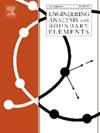弹性浮式海上风力发电机的波浪-流-风相互作用
IF 4.2
2区 工程技术
Q1 ENGINEERING, MULTIDISCIPLINARY
Engineering Analysis with Boundary Elements
Pub Date : 2025-02-01
DOI:10.1016/j.enganabound.2024.106052
引用次数: 0
摘要
研究了浮式海上风力机在波浪、流和风荷载作用下的刚体响应和弹性运动。基于格林函数的线性衍射理论和叶片单元动量法,分别在频域上建立了小流速的数值计算方法和气动分析方法。将该方法与有限元方法相结合,得到了FOWTs的水弹性和气弹性运动。考虑了波-流-风组合与SPAR、半潜式和驳船的相互作用。将三种FOWTs对波浪和风的刚体响应与有电流荷载时的刚体响应进行了比较。此外,本文还研究了流速和入射波与流风的失向对波导运动的影响。讨论了考虑波流相互作用和气动载荷对所考虑的气动动力系统响应的重要性。结果表明,当外加电流荷载时,SPAR - FOWT对波浪和风的运动变化最大。最后,研究了波浪-流-风相互作用对柔性fowt弹性运动的影响,并与刚体fowt进行了比较。本文章由计算机程序翻译,如有差异,请以英文原文为准。
Wave–current–wind interaction with elastic floating offshore wind turbines
This study is concerned with rigid-body responses and elastic motion of floating offshore wind turbines (FOWTs) under combined wave, current and wind loads. A numerical approach is developed in frequency domain based on the linear diffraction theory with a Green function for small current speeds and the blade-element momentum method for hydrodynamic and aerodynamic analysis, respectively. This approach is coupled with the finite-element method to obtain the hydro- and aeroelastic motion of FOWTs. The interaction of combined wave–current–wind with three FOWTs, namely SPAR, semisubmersible and barge, is considered. Rigid-body responses of the three FOWTs to waves and wind are compared to those when current loads are present. Furthermore, the effect of current speed and misalignment of incident waves with current-wind on the motion of the FOWTs is investigated. Discussion is provided on the importance of considering wave–current interaction together with aerodynamic loads on the responses of the considered FOWTs. It is observed that the motion of the SPAR FOWT to combined waves and wind changes the most when the current loads are added. Finally, the effect of wave–current-wind interaction on the elastic motion of flexible FOWTs is investigated and compared with their rigid-body counterparts.
求助全文
通过发布文献求助,成功后即可免费获取论文全文。
去求助
来源期刊

Engineering Analysis with Boundary Elements
工程技术-工程:综合
CiteScore
5.50
自引率
18.20%
发文量
368
审稿时长
56 days
期刊介绍:
This journal is specifically dedicated to the dissemination of the latest developments of new engineering analysis techniques using boundary elements and other mesh reduction methods.
Boundary element (BEM) and mesh reduction methods (MRM) are very active areas of research with the techniques being applied to solve increasingly complex problems. The journal stresses the importance of these applications as well as their computational aspects, reliability and robustness.
The main criteria for publication will be the originality of the work being reported, its potential usefulness and applications of the methods to new fields.
In addition to regular issues, the journal publishes a series of special issues dealing with specific areas of current research.
The journal has, for many years, provided a channel of communication between academics and industrial researchers working in mesh reduction methods
Fields Covered:
• Boundary Element Methods (BEM)
• Mesh Reduction Methods (MRM)
• Meshless Methods
• Integral Equations
• Applications of BEM/MRM in Engineering
• Numerical Methods related to BEM/MRM
• Computational Techniques
• Combination of Different Methods
• Advanced Formulations.
 求助内容:
求助内容: 应助结果提醒方式:
应助结果提醒方式:


